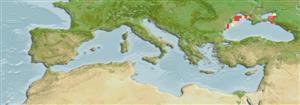分類 / Names
俗名 | 同種異名 | Catalog of Fishes(屬, 種) | ITIS | CoL | WoRMS | Cloffa
Teleostei >
Clupeiformes (Herrings) >
Alosidae (Shads and Sardines)
Etymology: Alosa: Latin, alausa = a fish cited by Ausonius and Latin, halec = pickle, dealing with the Greek word hals = salt; it is also the old Saxon name for shad = "alli" ; 1591 (Ref. 45335).
Environment: milieu / climate zone / depth range / distribution range
生態學
海洋; 淡水; 半鹹淡水; 溯河洄游 (Ref. 51243). 溫帶; 48°N - 37°N, 27°E - 54°E
Eurasia: Black Sea, Sea of Azov and Caspian Sea.
歐亞大陸: 黑海,亞速海與裡海。
大小 / 重量 / 年齡
Maturity: Lm ? range ? - ? cm
Max length : 32.0 cm TL 雄魚/尚未辨別雌雄; (Ref. 593); common length : 20.0 cm SL 雄魚/尚未辨別雌雄; (Ref. 188); 最大體重: 250.00 g (Ref. 593); 最大年齡: 7 年 (Ref. 10549)
背棘 (總數): 0; 臀棘 0. Body `shad-like', usually rather deep and compressed. Total gill rakers 50 to 180, long and thin, distinctly longer than filaments. Teeth poorly developed in jaws, sometimes barely detectable. A black spot posterior to gill opening and occasionally further black spots on flank in some cases.
身體像非魚類一樣的', 通常相當深而扁長形的。 總鰓耙 50 到 180, 長而細又明顯長度超過絲狀突起。 齒在顎中發展不良的, 有時幾乎可發覺。 一個黑色的斑點在一些情況的側面上在鰓裂與偶然進一步的黑色斑點後面。
Schooling and migratory (Ref. 188); at sea, pelagic in coastal waters with steady current and avoids areas with stable salinity; migrates from sea to mouth of large rives and spawns in fresh- or slightly brackish-water at shallow sites washed by flow of large rivers. Males migrate upriver at 2-3 years, females at 4-5; many individuals reproduce 2-4 seasons. Two migration peaks, one in late April (mostly males), one in early May (mostly females), entering rivers when temperature rises above 10°C. Spawns when temperature is at least 15°C, in May to June. Spawning usually occurs in the upper 3 m. Eggs semi-pelagic and demersal. Spent fish migrate back to the sea; juveniles migrate to sea during first summer, remaining there until they mature. Feeds mainly on zooplankton (copepods and mysids) when at sea (Ref. 59043). Depending on the subspecies (10 subspecies known), some are semi-anadromous and spawn in fresh or slightly saline waters, mainly in the lower reaches, whereas others are practically marine and spawn in brackish or even fully saline oceanic waters. One of the most warm-loving Alosa of the Caspian. Only A. a. caspia of the Caspian Sea is of commercial importance (Ref. 188).
群游性與迴游的。 主要地在半淡鹹水生存, 但是進入淡水到產卵。 依據亞種而定,一些是半-溯河洄游產卵而且產卵於淡水或微鹹的水域中,主要在下面的範圍, 人而其它實際海洋而且產卵於半鹹淡或甚至完全鹽的大洋性水域中。 里海者的最喜歡溫暖 Alosa 之一。 吃浮游生物。 只有 A. 一。 裡海的 caspia 是有商業重要性。 知道的 10個亞種。
Life cycle and mating behavior
成熟度 | 繁殖 | 產卵場 | 卵 | 孕卵數 | 仔魚
Depending on the subspecies some are semi-anadromous and spawn in fresh or slightly saline waters, mainly in the lower reaches, whereas others are practically marine and spawn in brackish or even fully saline oceanic waters (Ref.188).There are two migration peaks, one in late April (mostly males) and one in early May (mostly females). Spent fish migrate back to sea. Juveniles migrate to sea during first summer, remaining at sea until they mature (Ref. 59043).歐亞大陸: 黑海,亞速海與裡海。
Whitehead, P.J.P., 1985. FAO Species Catalogue. Vol. 7. Clupeoid fishes of the world (suborder Clupeoidei). An annotated and illustrated catalogue of the herrings, sardines, pilchards, sprats, shads, anchovies and wolf-herrings. FAO Fish. Synop. 125(7/1):1-303. Rome: FAO. (Ref. 188)
人類使用
漁業: 高經濟性
更多資訊
參考文獻養殖養殖資訊品種遺傳學Electrophoreses遺傳率疾病加工NutrientsMass conversion
合作者照片Stamps, Coins Misc.聲音神經毒速度泳型鰓區Otoliths腦重體重比眼睛色素
工具
特別的報告
下載 XML
網路資源
Estimates based on models
Phylogenetic diversity index (Ref.
82804): PD
50 = 0.5000 [Uniqueness, from 0.5 = low to 2.0 = high].
Bayesian length-weight: a=0.00891 (0.00591 - 0.01344), b=2.97 (2.85 - 3.09), in cm total length, based on LWR estimates for this species & Genus-body shape (Ref.
93245).
營養階層 (Ref.
69278): 3.5 ±0.46 se; based on food items.
Generation time: 3.7 ( na - na) years. Estimated as median ln(3)/K based on 1
growth studies.
回復力 (Ref.
120179): 中等的, 族群倍增時間最少 1.4 - 4.4年 (tmax=7).
Fishing Vulnerability (Ref.
59153): Low to moderate vulnerability (34 of 100).
Nutrients (Ref.
124155): Calcium = 16.7 [7.1, 87.1] mg/100g; Iron = 0.673 [0.290, 1.421] mg/100g; Protein = 19.1 [16.5, 21.8] %; Omega3 = 1.43 [0.76, 2.77] g/100g; Selenium = 10.4 [5.1, 20.6] μg/100g; VitaminA = 29.1 [7.3, 113.9] μg/100g; Zinc = 0.372 [0.231, 0.630] mg/100g (wet weight);
